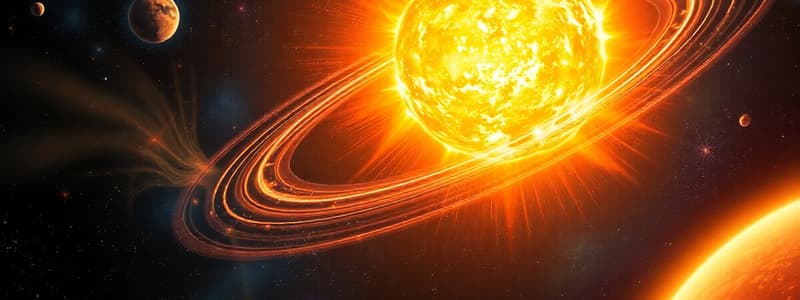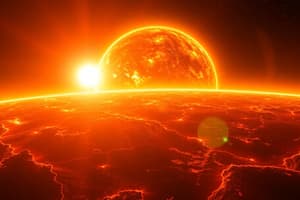Podcast
Questions and Answers
The Earth's axis tilts at ___ degrees.
The Earth's axis tilts at ___ degrees.
23.5
Energy from the sun travels in ___ and radiates to Earth.
Energy from the sun travels in ___ and radiates to Earth.
waves
Plants convert solar energy into chemical energy through a process called ___.
Plants convert solar energy into chemical energy through a process called ___.
photosynthesis
___ occurs in the sun when 2 atoms collide & huge amounts of energy are released.
___ occurs in the sun when 2 atoms collide & huge amounts of energy are released.
___ is the process of splitting an atom to generate a massive amount of energy (such as uranium).
___ is the process of splitting an atom to generate a massive amount of energy (such as uranium).
At one point in time, astronomers believed our solar system was a ___ model.
At one point in time, astronomers believed our solar system was a ___ model.
From past astronomers' discoveries, we now know that our solar system is a ___ model.
From past astronomers' discoveries, we now know that our solar system is a ___ model.
The common point in which two celestial objects orbit is called the ___.
The common point in which two celestial objects orbit is called the ___.
What causes auroras?
What causes auroras?
[Satellite] - ___.
[Satellite] - ___.
Example of natural satellite: ___.
Example of natural satellite: ___.
Example of artificial satellite: ___.
Example of artificial satellite: ___.
[Telescope] - ___.
[Telescope] - ___.
What are the Terrestrial planets?
What are the Terrestrial planets?
What are the Jovian planets?
What are the Jovian planets?
[Precession] - ___.
[Precession] - ___.
[Nutation] - ___.
[Nutation] - ___.
[Kepler's 1st Law] - ___.
[Kepler's 1st Law] - ___.
[Kepler's 2nd Law] - ___.
[Kepler's 2nd Law] - ___.
[Kepler's 3rd Law] - ___.
[Kepler's 3rd Law] - ___.
Flashcards are hidden until you start studying
Study Notes
Earth's Axis and Solar Energy
- The Earth's axis is tilted at approximately 23.5 degrees.
- The sun serves as the primary energy source for the solar system, with energy traveling in the form of electromagnetic radiation.
- Plants convert solar energy into chemical energy through photosynthesis.
Nuclear Reactions
- Nuclear fusion occurs in the sun, involving the collision of two atoms which releases vast amounts of energy.
- Nuclear fission is the process of splitting an atom, releasing a significant amount of energy, used in nuclear power plants.
Historical Models of the Solar System
- The geocentric model was an early belief that all planets revolved around the Earth.
- The heliocentric model represents the modern understanding that the solar system is centered around the sun.
Orbital Dynamics
- The focal point shared by two celestial objects in orbit is called the barycenter.
Auroras
- Auroras are caused by the interaction of solar wind with Earth's magnetic field, resulting in visible light displays near polar regions.
Satellites
- Natural satellites are celestial bodies that orbit planets; an example is Earth's Moon.
- Artificial satellites are man-made objects placed in orbit; an example is the Hubble Space Telescope.
Telescopes
- Telescopes are instruments that magnify distant celestial objects, enabling astronomers to study stars, planets, and galaxies.
Terrestrial and Jovian Planets
- Terrestrial planets, composed mainly of rock and metal, include Mercury, Venus, Earth, and Mars.
- Jovian planets, known for their gas composition, include Jupiter, Saturn, Uranus, and Neptune.
Precession and Nutation
- Precession is the gradual change in the orientation of Earth's rotational axis over time.
- Nutation is a smaller oscillation superimposed on the precession of Earth's axis, caused by gravitational forces from the moon and sun.
Kepler's Laws of Planetary Motion
- Kepler's 1st Law states that planets follow elliptical orbits with the sun at one of the foci.
- Kepler's 2nd Law, or the law of equal areas, indicates that a line connecting a planet to the sun sweeps out equal areas during equal intervals of time.
- Kepler's 3rd Law expresses that the square of a planet's orbital period is proportional to the cube of the semi-major axis of its orbit.
Studying That Suits You
Use AI to generate personalized quizzes and flashcards to suit your learning preferences.




